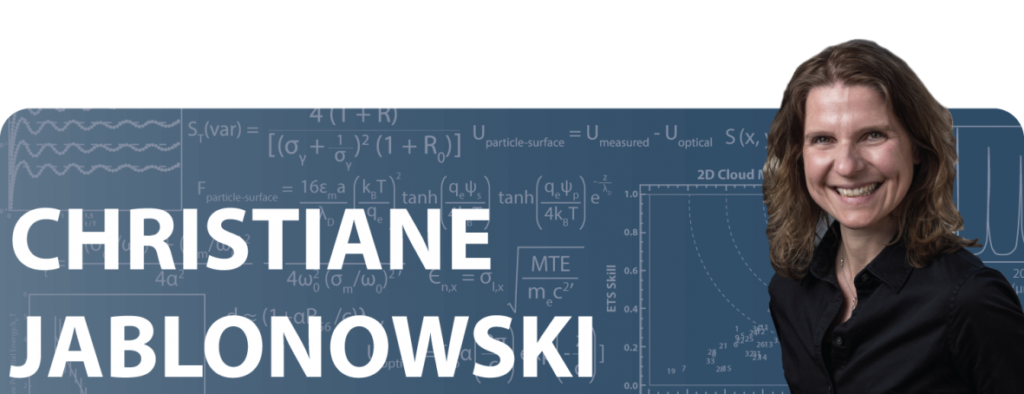WHAT DID THE 2010 EARLY CAREER AWARD ALLOW YOU TO DO?
In particular, the research pushed the frontiers in climate and weather modeling by introducing Adaptive Mesh Refinement (AMR) and other Variable-Resolution (VR) techniques into future-generation atmospheric models that can dynamically or statically vary their mesh spacings between 1-400 km. This approach demands novel numerical algorithms for the fluid dynamics equation set, the ‘dynamical core’, that describes the interplay between wind, temperature, pressure and density. A dynamical core is considered the heart of climate and weather models.
In particular, this research project advanced high-order algorithms for ‘nonhydrostatic’ fluid dynamics equation sets that are suitable for all scales. Special attention was paid to a ‘cubed-sphere’ computational mesh and high-performance computing. Picture a six-faced cube with eight corner points, blow it up and project it onto a globe. These six ‘cubed-sphere’ faces are rectangular patches that can be subdivided infinitely. Such variable-resolution cubed-sphere meshes enable the atmospheric community to focus the computational resources on features or regions of interest, and thereby allow an assessment of the many multi-scale interactions in the climate system.
For example, the research revealed how highly-resolved tropical cyclones interact with the general circulation of the atmosphere, how cyclones can be dynamically tracked with high-resolution meshes, and what the impact of highly-resolved mountain ranges is on local wind systems.
ABOUT:
Christiane Jablonowski is an associate professor in the Department of Climate and Space Sciences and Engineering at the University of Michigan.
SUPPORTING THE DOE SC MISSION:
The Early Career Award program provides financial support that is foundational to young scientists, freeing them to focus on executing their research goals. The development of outstanding scientists early in their careers is of paramount importance to the Department of Energy Office of Science. By investing in the next generation of researchers, the Office of Science champions lifelong careers in discovery science.
For more information, please go to the Early Career Research Program.
THE 2010 PROJECT ABSTRACT:
Introducing Enabling Computational Tools to the Climate Sciences: Multi‐Resolution Climate Modeling with Adaptive Cubed‐Sphere Grids
The objective of this effort is to develop a modern climate circulation model that enables computational resources to be focused on regions of greatest change. The research will develop a new atmospheric model appropriate for climate simulations that introduces state‐of‐the‐art techniques for resolving multiple scales. These techniques, collectively known as adaptive mesh refinement, allow extreme‐scale computational resources to be focused on spatial regions of greater interest, such as coastlines or mountain ranges, or on hard‐to‐resolve phenomena, such as cyclones. Success will result in more efficient climate simulations that capture more small‐scale atmospheric phenomena than would otherwise be possible.
RESOURCES:
J.O. Ferguson, C. Jablonowski, H. Johansen, P. McCorquodale, P. Colella and P. A. Ullrich, “Analyzing the adaptive mesh refinement (AMR) characteristics of a high-order 2D cubed-sphere shallow-water model.” Monthly Weather Review 144, 4641 (2016). [DOI: 10.1175/MWR-D-16-0197.1]
C.M. Zarzycki, C. Jablonowski, D.R. Thatcher and M.A. Taylor, “Effects of localized grid refinement on the general circulation and climatology in the Community Atmosphere Model.” Journal of Climate 28, 2777 (2015). [DOI: 10.1175/JCLI-D-14-00599.1]
P.A. Ullrich and C. Jablonowski, “MCore: A non-hydrostatic atmospheric dynamical core utilizing high-order finite-volume methods.” Journal of Computational Physics 231, 5078 (2012). [DOI: 10.1016/j.jcp.2012.04.024]
Additional profiles of the 2010 Early Career Award winners can be found at: https://www.energy.gov/science/listings/early-career-program.
The Office of Science is the single largest supporter of basic research in the physical sciences in the United States and is working to address some of the most pressing challenges of our time. For more information, please visit www.energy.gov/science.
Original post https://alertarticles.info



